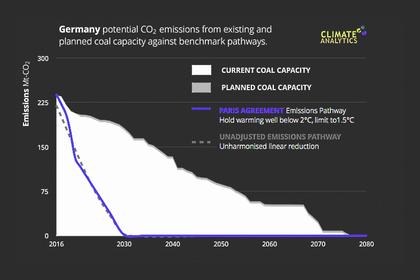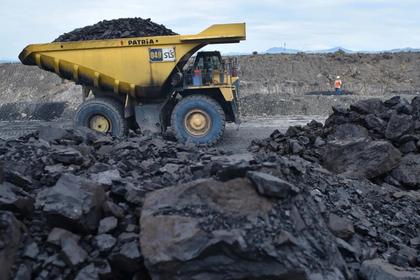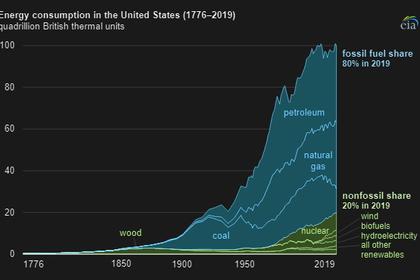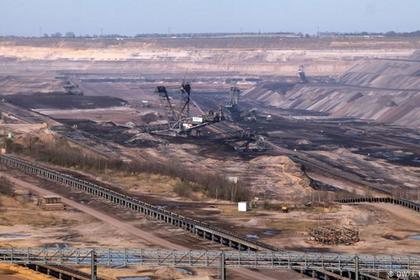
U.S. COAL DOWN
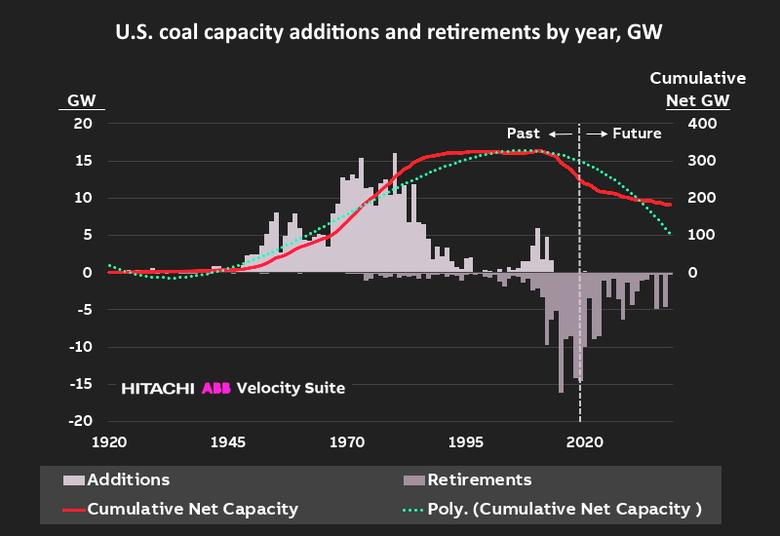
By Kent Knutson Energy Market Content Specialist Hitachi ABB Power Grids
ENERGYCENTRAL - Across the United States, the abundant supply of low-cost natural gas and a growing portfolio of gas power plants have put extreme pressure on coal power economically. Combine that with the high growth in wind, solar and energy storage projects, and the ever-increasing carbon-reduction goals being set by states, communities, utilities, and corporations, and you have the perfect storm. The result is reduced plant utilization rates and the continued stream of announcements for the early closure of coal assets, including some of the largest power plants in America.
For the better part of three decades, from 1985 through 2014, net operating coal capacity in the United States exceeded 300 GW. By the end of 2020, it is expected to drop below 240 GW for the first time since 1978, and by 2030, based on plants scheduled for retirement, net capacity is expected to dip below 200 GW for the first time since 1975. This is based on data compiled by the Hitachi ABB Power Grid's Velocity Suite research team.
Coal accounted for only 17.2% of the country's fuel mix through the first four months of 2020 – down 33.6% from the same period in 2019. Meanwhile, natural gas was running 10% higher and accounted for 39.7% of the country's fuel mix, while solar, wind and other non-hydro renewables accounted for a record 13.4% of the total fuel mix – up 11.2% from the same four-month period in 2019.
Early retirement set for large coal-fired unit in Georgia
On June 26, 2020, the board of directors of Jacksonville, Florida-based utility JEA, announced they had signed a 20-year contract with Florida Power & Light (FPL) to replace power from the JEA's minority ownership (23.6%) in the 891 MW Unit 4 at Georgia Power-operated Plant Scherer. FPL owns the remaining 76.4% of Unit 4.
Plant Scherer is currently the largest operating coal-fueled plant in the United States with a nameplate capacity of roughly 3,564 MW. The new contract will start when unit four is retired early in 2022, making Georgia Power's Plant Bowen the largest operating plant in the United States.
Owners of the three remaining units at Plant Scherer include:
- Units 1 & 2 (1,782 MW combined) – Oglethorpe Power Corp (60%), Municipal Electric Authority of Georgia (30.2%), Georgia Power Company (8.4%), and the City of Dalton, Georgia (1.4%)
- Unit 3 (891 MW) – Georgia Power Company (75%), and NextEra Energy’s Gulf Power Company (25%)
Georgia Power owns 100% of all four units (3,499 MW combined) at Plant Bowen.
Largest coal plants set to trade positions in 2022
Southern Company subsidiary Georgia Power operates the two largest coal-fueled power plants in the United States – both are in the state of Georgia. Plant Bowen, the second-largest coal plant in the country, located near Cartersville in Bartow County, is comprised of four generating units built in the early 1970s with a total installed nameplate capacity of 3,499 MW. Plant Scherer, the largest operating coal plant, is also comprised of four generating units with a combined nameplate capacity of 3,564 MW. Plant Scherer is located near the city of Juliette in Monroe County. The plant is named for the former chairman and chief executive officer of Georgia Power, Robert W. Scherer.
The two plants have been huge power supply contributors since the first unit at Bowen started operation in 1971. During the two decades from 2000 through 2019, Plant’s Scherer and Bowen generated more than 750 million MWh, and as recently as 2010, the two behemoth plants combined generated more than 46.3 million MWh of electricity in a year. With the closure of Scherer Unit 4 in early 2022, Plant Bowen will become the largest coal-fired power plant based on installed operating capacity in the country. During the past decade, Plant Bowen has been running at about two-thirds of capacity. Electricity output averaged 14.3 million MWh per year over the ten-year period from 2010 through 2019 – down from 21.7 million MWh per year during the previous decade.
The lowest annual electricity production from both power plants was recorded during 2019 at 23.1 million MWh – about half of the decade peak of 46.3 million MWh generated in 2010.
Along with the upcoming shutdown of Scherer Unit 4, there have been several recent announcements for early coal plant closures across the country, including:
- Craig Station (CO) Unit 2 (410 MW) is scheduled for closure in September 2028, Unit 1 (427 MW) was previously slated for retirement in 2025, with unit 3 (448 MW) slated for 2030. The plant is operated by Tri-State Generation and Transmission and is owned by five western utilities including Tri-State.
- Platte River Power Authority’s (CO) Rawhide Coal Plant (280 MW) is slated to close by 2030
- Colorado Springs Utilities (CO) announced the early closure of their two remaining coal plants, Martin Drake (207 MW) and Ray D Nixon (207 MW) in 2023 and 2030 respectively
- Tucson Electric’s (AZ) two units at the Springerville Generating Station (845.6 MW combined) are scheduled to close in 2027 and 2032.
The early closure of Unit 4 at Plant Scherer follows national trends where nearly 100 GW of coal-fired generating capacity has retired since 2000, and between now and 2025 an additional 25 GW are slated for closure. Driven by economics, competitively priced natural gas, and a surge in cost-competitive renewables and energy storage projects, coal as a utility fuel is in steep decline across America.
-----
This thought leadership article was originally shared with Energy Central's Generation Professionals Group. The communities are a place where professionals in the power industry can share, learn and connect in a collaborative environment. Community today and learn from others who work in the industry.
-----
Earlier:

